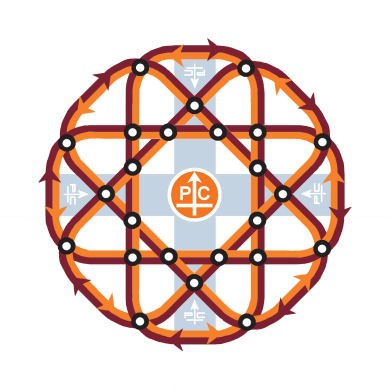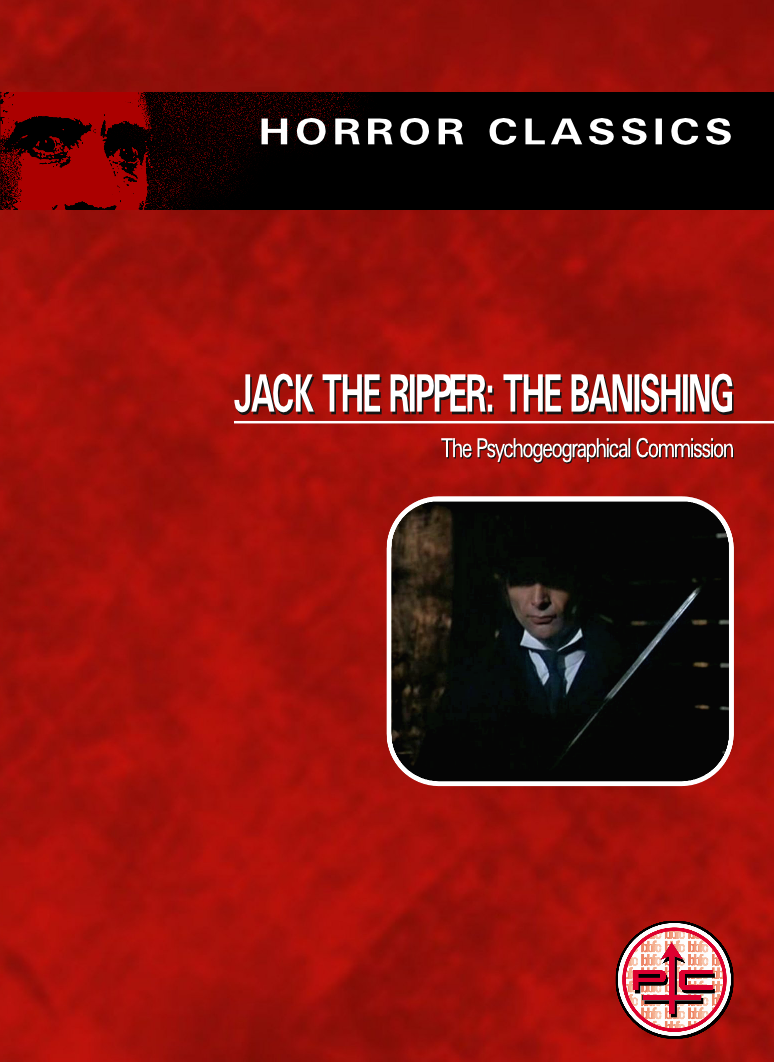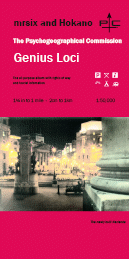
We had planned to record the outer (clockwise) line then replay it on the inner to negate the effect of the banishing, but then decided we'd subtly change its phase to glimpse behind the protection without dropping the shield altogether. Beginning and ending at Hillhead Station, we recorded over the period of totality on the winter solstice eclipse 2010, the first time a total eclipse has fallen on a winter solstice since the days of Prophet Peden (1638). This recording was then soundscaped and played back on the inner circle late one evening at beginning of Feb 2011. Because of differences in passenger numbers, platform delays and speed between morning and night trips our recording soon fell out of sync with the passing stations as intended. A notable increase in the train’s vibration was then felt; four people in the carriage fell asleep and needed to be roused in order to prevent them missing their stops and those used to taking audio cues from the train were standing in sync with the music and moving towards the doors only to find the train not slowing down. Confusion soon turned to aggression giving us a glimpse at what lay inside the protection field and we curtailed our experiment and ran, allowing the banishment to return.
The polymath Alasdair Gray wrote in Lanark: A Life in Four Books, of a vision concerning a mouth opening in a stone face within the Glasgow Necropolis which transported Lanark to Unthank, an altogether different, darker, Glasgow. We believe the portal is to the west of that, and within a few years, as the city moves slowly into alignment, they should coexist upon the Grey Ridge, the centre of the Subway ritual.
miniCD in 8cm DVD case packaging
£5 + £1 P&P (Worldwide)

Digital Downloads + PDF artwork available at Bandcamp
Reviews
The Marshman Chronicles
I was walking clockwise round the marsh, listening to an anti-clockwise journey. My eyes were overground, my ears underground. My body in London, my mind in Glasgow. I was twisting layers of time-space like it was a Rubik’s Cube.
A rift had opened up right before me. A portal between universes!
For a moment I danced in and out of it. Stuck my arm through the earth’s crust. Lifted my eyes to the sky. Breathed the summer air. Pushed my tongue deep between the electric lines and let Scottish rats run over my teeth. An old woman hobbled past with her dog and - cackling - I flipped her into the bowels of Glasgow as a blood sacrifice.
This psychetecture is probably not what the makers of Widdershins intended. Goes without saying.
But even separated from its context, the music works. The rhythm cycles of the journey are played out by the gaps between stations, the peaks of acceleration, the chorus of closing doors, the phasing of entropic squeaks and hisses into something original. When laid on top of a totally opposite topography, it released – for me, at least - a symphony of synchronicities and parallels.
A right old mashup, in fact.
Space is a formidable auteur.
MusiqueMachine
The inner circle of the Glasgow Subway system doesn’t immediately suggest a venue for ritual. Its modern carriages merely ensure busy people reach their desired destination efficiently, unaware of their precise location until a big, clear sign rushes in to view. It’s a collectively ignored experience, an interim between A and B, where most seem encouraged to block out the environment by book or rag, phone or ad, as they’re herded beneath the city surface.
And yet, as the mysterious Psychogeographical Commission point out, the anticlockwise travelling of the subway’s inner circle can be viewed as a constant banishing ritual first performed in the late nineteenth century when an accident that stalled its opening provided a blood sacrifice distributed circuitously ever since.
With ‘Widdershins’ the duo of S.: and Hokano once again seek to address this disconnect they perceive between urban dwellers and their local mythologies. However, while their previous releases have more generally encouraged listeners to re-evaluate city situations through treated layers of ambient guitar and electronics to soundtrack exploratory strolls along lost rivers and secret historical tramways, ‘Widdershins’ is a straight recording of the noise of travelling on Glasgow’s underground.
Or is it? Through concentrating on the sounds of this 24 minute journey with its beeping electronic doors bookending the rhythmic rush of wheels as the engine accelerates and decelerates, one starts to perceive a change in mood, or a subtle presence, as the detail of the once familiar noises starts to reveal new qualities. Have The Commission deftly tweaked the tube sounds to invoke a sense of dread and otherness or have they merely separated the sound from its source and presented it in such a way that we finally take notice of what was there all along?
Either way it makes for a compelling listening, especially when using similar transport, bathing a journey in its altered light. Indeed, the duo apparently played the recording back into its source on a subsequent late night round trip and, in doing so, inspired aggression in those passengers who erroneously responded to its beeping doors as the recording fell out of sync with the train and, perhaps, the protection afforded by Glasgow’s secret banishing ritual.
4/5
Obskure Magazine
Avec leurs deux précédents albums, The Psychogeographical Commission ont suscité l’enthousiasme chez certains qui ont vu en eux des héritiers de groupes expérimentaux aussi majeurs que Contrastate ou Coil, mais ici le duo nous propose quelque chose de tout à fait différent de ce à quoi ils ont pu nous habituer. En effet, les motivations conceptuelles quant à la psycho-géographie ont toujours été présentes dans les compositions et les packagings des disques. Entre deux enregistrements plus conséquents, le duo nous offre cet objet de recherche, basé sur des prises de sons, qui se concentre sur le cercle interne du métro de Glasgow. En effet, celui-ci se déplace dans le sens inverse des aiguilles d’une montre. Cette ligne souterraine, ouverte en décembre 1896, est une des plus anciennes au monde. Certains dirent que ce système était damné et des sacrifices de sang furent commis. S’intéressant aux effets psychologiques et magiques du déplacement dans l’espace, ce rituel quotidien a interpellé le groupe pour sa résonance sur la psyché des centaines de personnes qui montent à bord de cette rame chaque jour. Pas de guitares ici ou de chant, juste des sonorités synthétiques mélangées aux avancées du train, ses arrêts, ses accélérations, ses vibrations, la notion même de musique devient hors propos. Nous sommes mis dans la position du passager, réceptif à l’environnement sonore. Un enregistrement à écouter au casque, qui développe encore plus loin la recherche du groupe. Un ticket de métro est même fourni avec le disque.
Vox Empirea
"Urban-folk", "Subway Underground-music", "City-ambient": sono solo alcuni dei termini utilizzati per catalogare lo stile compositivo di questo particolare progetto di Glasgow che dal 2008 è impersonato dal duo S. e Hokano i quali suddividono le rispettive competenze tra strumentalità acustiche e virtuali. Per la terza occasione mi accingo quindi ad analizzare e recensire un disco proveniente da una straordinaria e caparbia passione per tutto ciò che di introspettivo e spirituale esiste nell'ambito metropolitano.
Le due precedenti opere su full-lenght "Genius Loci", l'acclamato debut, ed il successivo "Patient Zero", sono caratterizzati da tracce i cui contenuti sondano e captano i recessi più imperscrutabili della città, estrapolando da essi l'essenza metafisica, gli echi occultati dal frastuono, le sottili vibrazioni psichiche emanate dagli abitanti oltre ad un'infinita serie di aspetti invisibili all'occhio umano ma ugualmente presenti e vividi tra le strade, gli edifici ed il sot tosuolo. Il risultato di tale, complicata indagine, viene trasmutato in suono, il quale riesce a far confluire nella fantasia dell'ascoltatore predisposto le forme e le sensazioni della mitologia urbana, quale fosse l'inizio di una nuova, affascinante frontiera della scienza.
La tecnica musicale adottata dai The Psychogeographical Commission spazia da sonorità rarefatte ai moduli rumoristici del field-recording, toccando inoltre armonie minimali sorrette da elettronica e chitarra con autentiche celebrazioni vocali espresse in modalità narrativa. Il cd-single ora in esame è licenziato, al pari dei due album sopracitati, dalla label Acrobiotic, proponendo un concept incentrato sulla storia, la cupezza e le vicissitudini che come un misterioso abbraccio avvolgono la vecchia metropolitana di Glasgow, location attorno alla quale sono state registrate sperimentalmente le buie acustiche incluse in questo mini-disc. "Widdershins" è un'unica suite lunga 24 minuti, dalle sonorità acquisite nei tunnel della metropolitana durante lo specifico arco temporale incluso tra il Solstizio invernale del 2010 e l'eclissi totale avvenuta esattamente in quel periodo; i tenebrosi soundscapes incisi diffondono prevalentemente il rombo del treno che corre sui binari alternato a pads di discendenza psychedelic-ambient, vibranti picchi di rumore arcano ed aeree ventate di correnti sotterranee, elementi dalla musicalità praticamente inesistente ma in grado di trasportare la mente all'interno di un vortice dalle pareti color inchiostro, entro le quali la temperatura percepita dal corpo risulta prossima allo zero. Il "cerchio antiorario", ovvero il percorso direzionale intrapreso station by station dalla linea metropolitana di Glasgow, assume un simbolismo da dimensione parallela che gli attenti osservatori The Psychogeographical Commission hanno saputo estrarre ed incanalare in un piccolo oggetto sonoro dall'aura misteriosa ed evocativa.
Ep limitato a sole 125 copie, "Widdershins" include ne l suo minuscolo packaging un biglietto della SPT Subway, quale memoria di un'esperienza innaturalmente oscura che potrete vivere preferibilmente a luci spente, nottetempo ed attraverso le cuffie. Buon viaggio.
Side Line
We here can speak about a strange project although once more urban and original. 'Widdershins' deals about the anticlockwise (widdershins) direction of the Glasgow Subway system. Together with the release we still get a map of the Subway (still called 'Clockwork Orange' because of the bright orange trains) and a ticket.
Musically, you can easily recognize the soundfield recordings, which of course all happened in the Subway. It creates a strange soundscape mixing the sharp and metallic sounds from the wheels on the rails and the trains passing by. It sounds a bit surreal, icy and experimental as well. The Psychogeographical Commission will appeal for the lovers of the Staalplaat releases. This legendary label in a way became specialized in the release of such bizarre concepts.
I prefer the 'Genius Loci'album, but this duo has the right approach plus an original concept to make it in the very restricted scene of experimentalism.<





